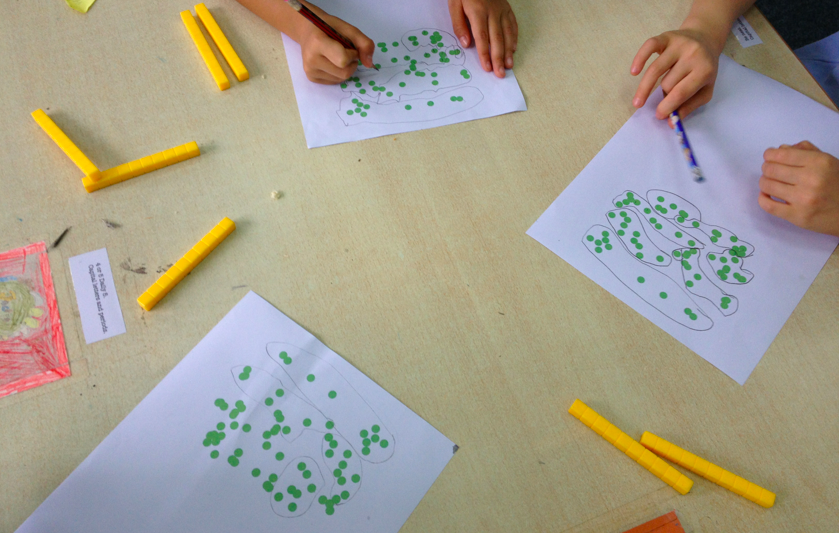Three Acts – Counting with dots and first graders
I had an amazing time this afternoon visiting my wife’s first grade class. I’ve been talking forever about how great it is to take a step out of the usual routines in class and look at a new problem, and my wife invited me in to try it with her students.
Here’s the run-down.
Act 1
[wpvideo 8kq5u3Cf]
Student questions (and the number of students that also found the questions interesting):
- Why do the dots come together? (8)
- Why are the dots making pictures and not telling us what they mean? (8)
- Why are some dots going together into big dots, and others staying small? (13)
- Why do some of the dots form blue lines before coming together?
My questions (and the number of students that humored me):
- How many dots are there at the end? (8)
- What is the final pattern of dots after the video ends? (11)
Guesses for the number of dots ranged from a low of 20 to a high of 90.
Act 2
What information did they want to know?
- They wanted to see the video again.
- Seven students asked about the numbers of tens or ones in each group. (I jumped on the use of that vocabulary right away – it seemed they are comfortable using this vocabulary based on my conversations with them.)
- Any high school or middle school math teacher that wants to see how excited students can be when they are learning math needs to go take a group of elementary students through a three act. I wish I had done this during the dark February months when things drag for me. My wife asked me to do this to see how it works, but I think I got a lot more enjoyment out of the whole experience.
- I made a conscious decision not to include any symbolic numbers in this exercise. It adds an extra layer of abstraction that takes away from the students figuring out what is going on. I almost put it back in when I wasn’t sure whether it was obvious enough. I am really glad I left it out so the students could prove that they didn’t need that crutch.
- This is written in Javascript using Raphael. You can see a fully editable version of the code in this JSFiddle.
- All files are posted at 101 Questions in case you want to get the whole package.
I showed them the video and gave them this handout since I didn’t have video players for all of the students:
grouping dots
What happened then was a series of amazing conversations with some really energetic and enthusiastic kids. They got right to work organizing and figuring out the patterns.

Act 3
We watched the video and discussed the results and how they got their answers. Lots of great examples of student-created systems for keeping track of their counting. We then watched the Act 3 video:
[wpvideo N9OYqdqx]
While nobody had the total number correct, I was quite impressed with their pride in being close. More interesting was how little they cared that they didn’t get the exact answer. I asked who was between 70 and 80, and a few kids raised their hands, and then the same with 50 – 70. One student was one off. Most were within ten or so of the correct answer. The relationship between the guesses and their answers after analysis was something we touched upon, but didn’t discuss outside of some one-on-one conversations.
The absolute highlight of the lesson was when I asked why they thought nobody had the exact answer. One student walked up to the projector screen with out hesitation and pointed here:

She said “this is what made it tough” and then sat back down.
We had a little more time, so we watched a sequel video:
[wpvideo xjc26Gjj]
I asked what they saw that was different aside from the colors. One student said right away that he figured it out, the same student that first shouted out ‘tens!’ in Act 1. We lacked the time to go and figure it out, so we left it there as a challenge to figure out for the next class.
Footnotes:

